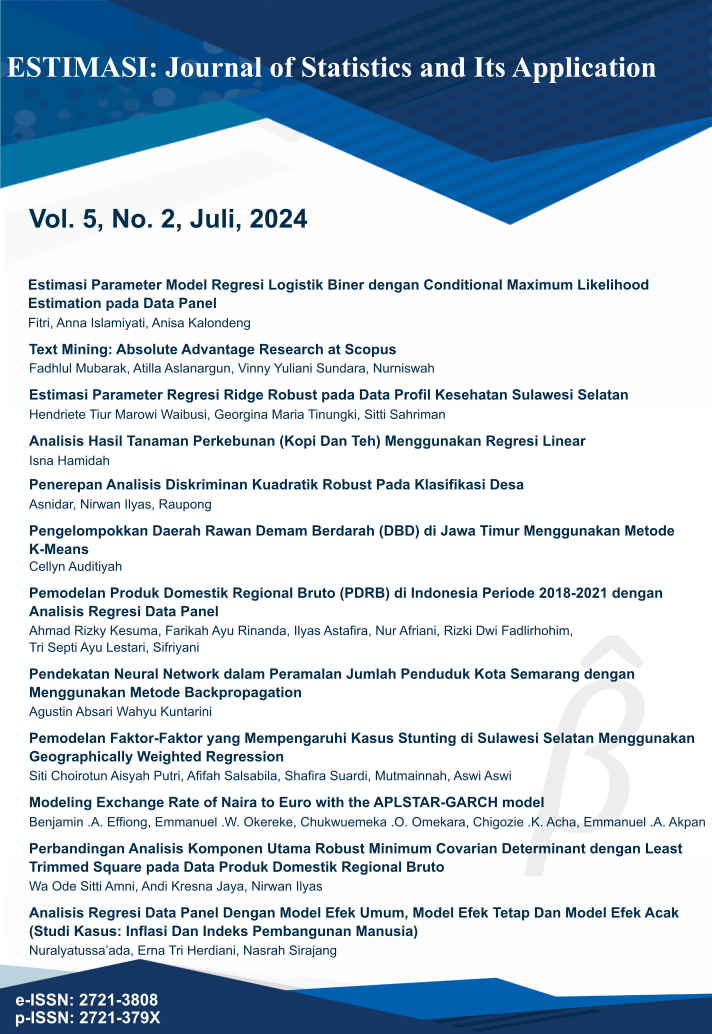Pengelompokkan Daerah Rawan Demam Berdarah (DBD) di Jawa Timur Menggunakan Metode K-Means
DOI:
https://doi.org/10.20956/ejsa.v5i2.27091Keywords:
Dengue Hemorrhagic Fever, Classification, K-MeansAbstract
Tropical diseases are common in areas with tropical and subtropical climates. As a country with a tropical climate, Indonesia is vulnerable to various tropical diseases. A large number of tropical diseases can occur in the temperate climate zone, differing only in the frequency with which they are affected. Dengue hemorrhagic fever is a tropical disease in Indonesia. DHF occurs as a result of infection with the dengue virus which is transmitted through the bite of the female Aedes aegypti mosquito. The high prevalence of DHF in East Java requires a data collection process to identify areas that are frequently infected with DHF. Therefore, we need a clustering system that can help classify areas that often experience DHF cases. This study aims to find out which districts/cities have the predominant cases of dengue fever. The clustering method used is K-Means clustering. Based on the research conducted, 2 clusters were obtained with a silhouette coefficient value of 0.76. Cluster 1 covers 36 districts/cities and is an area with a low level of vulnerability to dengue fever, while cluster 2 covers 2 districts/cities and is an area with a high level of vulnerability to dengue fever.
References
Masluhiya, S., AF, Wibowo, R. C. A., & Luthfin, A. Eksplorasi Sebaran Penyakit Demam Berdarah Dengue (DBD) dan Pneumonia di Kota Malang. JUMANTIK (Jurnal Ilm. Penelit. Kesehatan), 7(2), 134, 2022, doi: 10.30829/jumantik.v7i2.10402.
Sembiring, M. A. Penerapan Metode Algoritma K-Means Clustering Untuk Pemetaan Penyebaran Penyakit Demam Berdarah Dengue (Dbd). J. Sci. Soc. Res., 4(3), p. 336, 2021, doi: 10.54314/jssr.v4i3.712.
Kurniawan, R. E., Makrifatullah, N. A., Rosar, N., Triana, Y., & Kunci, K. Hubungan Sanitasi Lingkungan Rumah Tinggal dengan Kejadian Demam Berdarah. J. Ilm. Multi Disiplin Indones., 2(1), pp. 163–173, 2022, [Online]. Available: https://katadata.co.id/berita/2020/01/06/baru-83-peserta-bpjs-kesehatan-per-akhir-2019-
Widiastuti, S. H., & Jumardi, R. Pengelompokan Daerah Rawan Demam Berdarah dengan Metode K-Means Clustering. J. Inf. dan Teknol., 4(4), pp. 185–190, 2022, doi: 10.37034/jidt.v4i4.213.
Amelia, D., Padilah, T. N., & Jamaludin, A. Optimasi Algoritma K-Means Menggunakan Metode Elbow dalam Pengelompokan Penyakit Demam Berdarah Dengue (DBD) di Jawa Barat. J. Ilm. Wahana Pendidik., 8(11), pp. 207–215, 2022, [Online]. Available: http://jurnal.peneliti.net/index.php/JIWP/article/view/1907
Azwan, M., et al. Penerapan Algoritma K-Means Clustering dan Correlation Matrix Untuk Menganalisis Risiko Penyebaran Demam Berdarah di Kota Pekanbaru. JIMP J. Inform. Merdeka Pasuruan, 6(3), pp. 1–6, 2022.
Yuniar, V. T., Joegijantoro, R., & Cahyani, S. D. Pengaruh Tingkat Kepadatan Jentik Aedes Aegypti Terhadap Kejadian Demam Berdarah Dengue (DBD) di Desa Pandansari Kecamatan. J. Hig. Sanitasi, 2(2), pp. 57–63, 2022.
Dinata, R. K., Safwandi, S., Hasdyna, N., & Azizah, N. Analisis K-Means Clustering pada Data Sepeda Motor. INFORMAL Informatics J., 5(1), p. 10, 2020, doi: 10.19184/isj.v5i1.17071.
Herlinda, V., & Darwis, D. Analisis Clustering Untuk Recredesialing Fasilitas Kesehatan Menggunakan Metode Fuzzy C-Means. Darwis, Dartono, 2(2), pp. 94–99, 2021, [Online]. Available: http://jim.teknokrat.ac.id/index.php/JTSI
Nabila, Z., Rahman Isnain, A., & Abidin, Z. Analisis Data Mining Untuk Clustering Kasus Covid-19 Di Provinsi Lampung Dengan Algoritma K-Means. J. Teknol. dan Sist. Inf., 2(2), p. 100, 2021, [Online]. Available: http://jim.teknokrat.ac.id/index.php/JTSI
Gunawan, H., & Purwayoga, V. Data Mining Menggunakan Algoritma K-Means Clustering Untuk Mengetahui Potensi Penyebaran Virus Corona Di Kota Cirebon. J. Sisfokom (Sistem Inf. dan Komputer), 11(1), pp. 1–8, 2022, doi: 10.32736/sisfokom.v11i1.1316.
Wahyu Pribadi, W., Yunus, A., & Wiguna, A. S. Perbandingan Metode K-Means Euclidean Distance Dan Manhattan Distance Pada Penentuan Zonasi Covid-19 Di Kabupaten Malang. JATI (Jurnal Mhs. Tek. Inform., 6(2), pp. 493–500, 2022, doi: 10.36040/jati.v6i2.4808.
Siregar, P. P., Solikhun, S., & Siregar, Z. A. Penerapan Metode K-Means Dalam Mengelompokkan Persebaran Lahan Kritis Di Indonesia Berdasarkan Provinsi. Resolusi Rekayasa Tek. Inform. dan Inf., 2(4), pp. 145–151, 2022, doi: 10.30865/resolusi.v2i4.335.
Paembonan, S., & Abduh, H. Penerapan Metode Silhouette Coefficient untuk Evaluasi Clustering Obat. PENA Tek. J. Ilm. Ilmu-Ilmu Tek., 6(2), p. 48, 2021, doi: 10.51557/pt_jiit.v6i2.659.
Farissa, R. A., Mayasari, R., & Umaidah, Y. Perbandingan Algoritma K-Means dan K-Medoids Untuk Pengelompokkan Data Obat dengan Silhouette Coefficient di Puskesmas Karangsambung. J. Appl. Informatics Comput., 5(2), pp. 109–116, 2021, doi: 10.30871/jaic.v5i1.3237.
Agustian, D. R., & Darmawan, B. A. Analisis Clustering Demam Berdarah Dengue Dengan Algoritma K-Medoids (Studi Kasus Kabupaten Karawang). JIKO (Jurnal Inform. dan Komputer), 6(1), p. 18, 2022, doi: 10.26798/jiko.v6i1.504.
Anggraeni, D. S., & Enri, U. Pengelompokkan Data Kemiskinan Provinsi Jawa Barat Menggunakan Algoritma K-Means dengan Silhouette Coefficient. Temat. J. Teknol. Inf. Komun., 9(1), pp. 29–35, 2022, [Online]. Available: http://jurnal.plb.ac.id/index.php/tematik/article/view/901.
Downloads
Published
Issue
Section
License
Copyright
It is the author's responsibility to ensure that his or her submitted work does not infringe any existing copyright. Authors should obtain permission to reproduce or adapt copyrighted material and provide evidence of approval upon submitting the final version of a manuscript.


